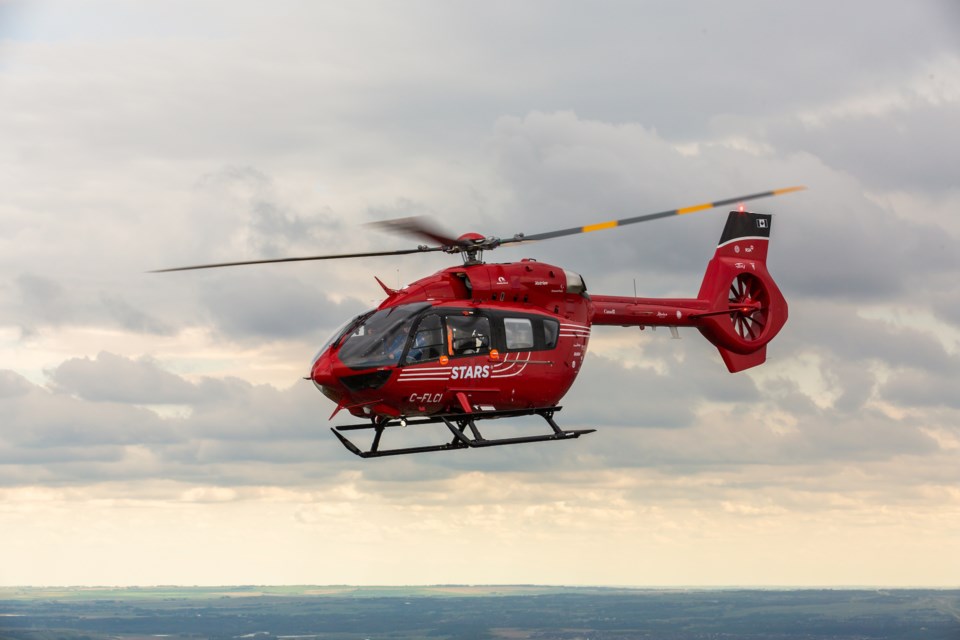ST. PAUL – The County of St. Paul has approved a motion to provide STARS Air Ambulance a contribution of $2.00 per capita, totalling $12,936 for 2023, during the Feb 14 council meeting.
During a delegation to the council last week, Glenda Farnden, Senior Municipal Relations Liaison with STARS Air Ambulance, also provided an update on STARS’ activities and 2022 statistics for St. Paul and surrounding areas.
According to Farnden, “STARS is fueled by generosity.”
She said STARS had a 10-year affiliation agreement with the Alberta Health Services (AHS) back in 2010. An extended agreement included a $5.5 million annual contribution toward STARS that expired in 2020.
STARS is currently discussing the potential of another multi-year agreement with AHS.
The Government of Alberta also provided 20 per cent of STARS’ yearly funding in the province, while 80 per cent came from fundraising efforts. The province then pledged to increase its contribution to 50 per cent in the future.
“So, at the end of last year, I’m very happy to announce that we did receive 50 per cent government funding in Alberta,” said Farnden. “It certainly does not mean that things are any easier for us as there are so many challenges.”
Farnden also noted support from municipalities across Alberta. “Currently, we are still over $2 million per year in sustainable support from our municipalities alone. It’s about five per cent of our total budget per year.”
Challenges
STARS’ mission volume significantly increased in the province due to COVID-19, according to Farnden, and it continues to increase every year. In 2022, STARS had over 3,500 missions across its six bases in three provinces.
In addition to mission volume, she also noted the increase in fuel costs and medical supplies. “Everything is continuing to just skyrocket,” she said, explaining the importance of receiving municipal and community support.
Expenditures
According to Farnden, more than three quarters of its expenditure goes toward aviation and medical expenditures - 52 per cent for aviation operations, 30 per cent for clinical operations, six per cent goes toward its STARS Emergency Link Centre (ELC), and 12 per cent is spent on base operations and administration.
For administration costs, the Canadian Revenue Agency (CRA) allows up to 35 per cent of administration costs for charitable entities, “and this is our fourth year that we remain at 12 per cent,” according to Farnden. “So, we very much feel we’re doing our due diligence in this area and have maintained this for many years.”
County of St. Paul
Farnden also updated council on its missions in the County of St. Paul over the past five years.
Information from STARS indicate approximately an annual average of over 40 missions per year in the County of St. Paul from 2018 to 2022; one near Ashmont, 12 near Elk Point, eight near Frog Lake, two near Glendon, 13 near Goodfish Lake, one near Myrnam, and 12 near St. Paul.
The information also includes critical inter-facility transfers by STARS at the St. Paul and Elk Point hospitals; 127 at the St. Paul Hospital and 34 at the Elk Point Hospital. Farnden explained that critical inter-facility transfers happen when critical patients from the St. Paul and Elk Point hospitals are transferred by STARS to hospitals that could provide the necessary care, including transfers to Edmonton.
According to Farnden, STARS have also flown County of St. Paul residents who were outside County of St. Paul boundary.
Accidents and illnesses “do not happen just because you’re close to home,” said Farnden. “It happens everywhere,” she said, explaining that STARS ultimately serves residents in the area even when they are outside the area.
“That is the testament to our partnership,” she said. “Your residents have access to STARS, and at no cost to them – no matter where they are in Western Canada.”
New helicopters
Farnden also updated council about the purchase of new helicopters. STARS has completed purchasing a total of 10 new H145 helicopters.
The $150 million capital campaign was made possible with contributions from all levels of government, communities, corporate and business supporters, and “very dedicated and devoted individuals.”
“Everyone was a part of this campaign that lasted just under five years,” said Farnden.
According to Farnden, the new fleet outperforms the last fleet STARS had. In addition, the H145s also has an Intensive Care Unit (ICU) and a variety of new equipment and technology, which involves having personnel with “very high-level expertise” to perform high-level critical care.
When asked by Deputy Reeve Maxine Fodness about STARS’ qualifications for its medical staff, Farnden stated they are highly trained. “We do require medical staff to have a minimum five years of critical care and emergency experience.”
They then undergo a three-month program and are required to undergo a mandatory 200 hours of annual hands-on simulation training with high fidelity mannequins, in addition to online textbook training. Pilots are also required to have “very high flight hours and night vision goggles experience,” she said, explaining that many of its pilots are former military personnel.
Farnden concluded by thanking the County of St. Paul for its ongoing support since 2015.



